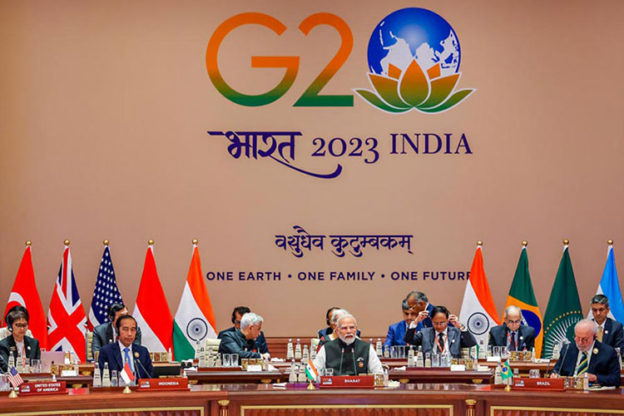This is a ground-breaking phenomenon and will staggeringly change the trade and connectivity perception between India, West Asia, and Europe.
The success of India’s G20 Presidency and its rise from the global south to the distinction of a leading player in global geopolitics speaks of the story of its grit, resilience, and determination. The secret of its roaring success comes from relying on its perennial cultural ethos of Vasudhaiva Kutumbakam – One Earth, One Family, One Future. The Sanskrit expression Vasudhaiva Kutumbakam embodies the essence of India’s wisdom tradition that believes in the culture of accommodation and shared success. The message of essential unity resonates in every aspect of the G20 arrangement. Several landmark decisions have been taken in the course of the events across the year. But the most historic one taken in the G20 summit at Bharat Mandapam is the India-Middle East -Europe Economic Corridor. This is a ground-breaking phenomenon and will staggeringly change the trade and connectivity perception between India, West Asia, and Europe. In this context, UAE, Saudi Arabia, and Israel are going to play a major role in this connectivity framework.
The India -Middle East-Europe Economic Corridor formation will be a multimodal one. This transcontinental passage will involve India, UAE, Saudi Arabia, Jordan, Israel, and Greece. In the event of India becoming a leading player in the international supply chain formulation, the goods from India are expected to move from Mumbai to UAE by ship and then from the UAE to Israel’s Haifa port requiring the usage of the railroad to transport them through UAE and Jordan. From Haifa Port, the consignments will cross the Mediterranean Sea to reach the port in Piraeus, Greece. This is the blueprint of the corridor which is drafted to act consequentially on making the supply chain resilient and uninterrupted. European Union’s specific interest in it and the involvement of the US, Germany, France, India, the UAE, and South Arabia crystallize the intent of developing an alternate supply chain system in order to decouple from the Chinese monopoly and its increasing aggressivity in the Indo-Pacific and elsewhere through its Belt and Road Initiative (BRI). This will reduce the circuitous Red Sea dependencies and Suez Canal congestions. The transshipment from India to Europe through this multimodal corridor is expected to take only ten days which is about 40% faster than the conventional route through the high traffic-prone Suez Canal. The ports that require restructuring and capacity-building include Mumbai Port Trust and Jawaharlal Nehru Port Trust, Dubai’s Jebel Ali Port, Israel’s Haifa and Greece’s Piraeus. India has made massive investments in this regard in the Haifa Port to expand its capacity. The UAE’s Etihad Rail has completed the railway line from Dubai Port to Al Ghweifat at the border between UAE and Saudi Arabia. It includes 139 km long rail connectivity. The Saudi Arabia Railway (SAR) is working to connect the two borders between the UAE and Jordan. A distance of 1392 km involving Haradh in southeast Saudi Arabia Al-Kharj, Riyadh, Buraidah, and Al-Haditha on the Saudi-Jordan border has been connected with the rail line. The section that needs quick completion is in Jordan and Israel connecting Haifa with Al-Haditha. The distance is assumed to be around 300 km. In addition to this, the UAE is planning for a 2000 km underwater rail connectivity between Mumbai and Dubai. If this cutting-edge and high-tech infrastructure sees the light of day, it will take the India-West Asia commercial corridor to a different height.
However, the multimodal transport corridor is expected to be functional in the near future. If this works out, India’s economy will jump in leaps and bounds. India’s demographic dividend, and its foray into critical technology such as semiconductors, green energy, artificial intelligence, space engineering, etc., will come to a definitive aid to make India a major player in the supply chain domain. The proposed corridor is also expected to attract deep and durable investments and outsourcings from Europe. In the event of India becoming the production hub, this commercial corridor will play a very critical role in maintaining uninterrupted connectivity. In the age of global warming, conventional energy resources will not be of much help and alternative energy resources will get top priority. If India succeeds in positioning itself as a manufacturing and marketing hub of the renewable energy industry and related fields, the corridor will embody immense significance. In the field of economic cooperation, this corridor will involve several key players from West Asia and Europe to forge a deeper and more meaningful partnership with India in order to make India emerge as a significant alternative to China’s brinkmanship and its BRI trappings. The proposed corridor is expected to give good dividends to the countries involved as it proposes to address the interests of everyone. Therefore, this corridor attracts enthusiasm from the partners involved. The Asian Highway project does not seem viable to reach Europe by road because it involves several countries and constraints and is perilously long. In comparison, the India-Middle East-Europe Economic Corridor is swift, direct, and effective.
https://www.financialexpress.com/opinion/india-middle-east-europe-economic-corridor-a-historic-decision-in-the-g20-summit/3245417/





